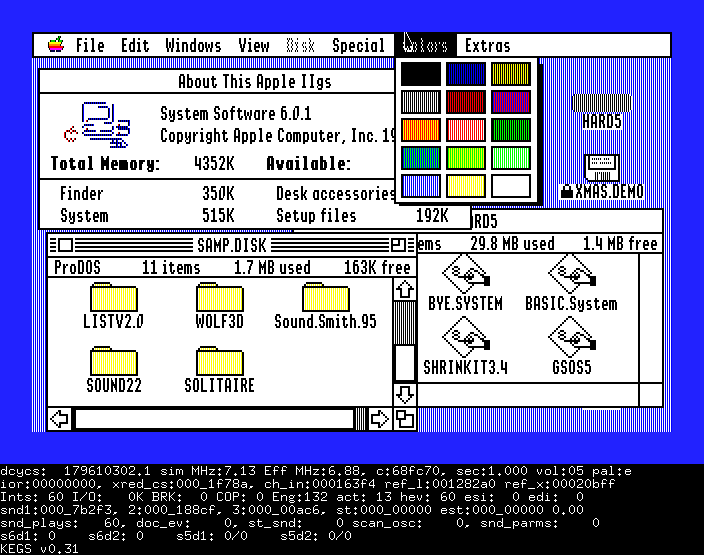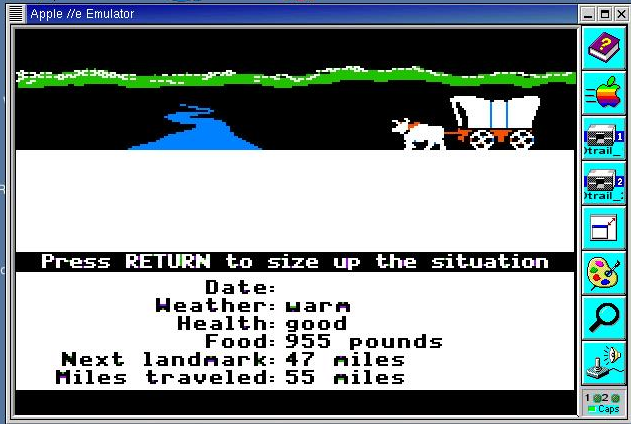

It also was the first Macintosh computer, simultaneously with the Macintosh SE, to use the Apple Desktop Bus (ADB), introduced with the Apple IIGS, for keyboard and mouse interface. The Macintosh II introduced space for an internal hard disk (originally 20 MB or 40 MB) and an optional second floppy disk drive.
APPLE IIGS EMULATOR MAC OS 9.2.2 SERIES
(Not to be confused with the Apple II series of non-Macintosh computers.) Introduced in March 1987 and retailing for the US $5,498, the Macintosh II was the first “modular” Macintosh model because it came in a horizontal desktop case like many PCs.Īll previous Macintosh computers used an all-in-one design with a built-in black-and-white CRT. The Apple Macintosh II was the first personal computer model of the Macintosh II series in the Apple Macintosh line. Beginning with the Macintosh II and culminating in the Macintosh IIfx, the Mac II series was Apple Computer’s high-end line from 1987 to 1991. The Macintosh II models were “modular” systems that did not include built-in monitors and were intended for business use.
APPLE IIGS EMULATOR MAC OS 9.2.2 PLUS
A compact Mac, the Plus had a 9-inch 512×342 pixel monochrome display with a resolution of 72 PPI.Ĭheck below the unboxing video of an Macintosh Plus: It had a new 3.5-inch double-sided 800 KB floppy drive, offering double the capacity of previous Macs along with backward compatibility. The Mac Plus was the first of many Macintoshes to use SIMMs. The Macintosh Plus was the last classic Mac to have a phone cord-like port on the front of the unit for the keyboard and the DE-9 connector for the mouse models released after the Macintosh Plus would use ADB ports. SCSI ports remained standard equipment for all Macs until the introduction of the iMac in 1998. Its SCSI implementation was engineered shortly before the initial SCSI spec was finalized and, as such, is not 100% SCSI-compliant.

Introduced as the Macintosh Plus, it was the first Macintosh model to include a SCSI port, which launched the popularity of external SCSI devices for Macs, including hard disks, tape drives, CD-ROM drives, printers, and even monitors. It originally had the same generally beige-colored case as the original Macintosh, but in 1987, the case color was changed to the long-lived, warm gray “Platinum” color. The Macintosh Plus computer was the third model in the Macintosh line, introduced on January 16, 1986, two years after the original Macintosh and a little more than a year after the Macintosh 512K, with a price tag of US$2599.Īs an evolutionary improvement over the 512K, it shipped with 1 MB of RAM standard, expandable to 4 MB, and an external SCSI peripheral bus, among smaller improvements. Pin Macintosh 128K – The First Macintosh (1984) The built-in display was a one-bit black-and-white and contained a 400 kB, single-sided 3.5-inch floppy disk drive and dedicated no space to other internal mechanical storage. By today’s standards, its specs are laughably anemic.īut the beloved box of bits was a far more affordable implementation of the graphical user interface. Its beige case contained a 9 in (23 cm) monitor and came with a keyboard and mouse.Īn indentation in the top of the case allowed the computer to be lifted and carried.

Macintosh, 128k, was introduced on Januit was the first commercially successful personal computer to feature a mouse and a graphical user interface rather than a command-line interface. Macintosh 128K – The First Macintosh (1984)


 0 kommentar(er)
0 kommentar(er)
